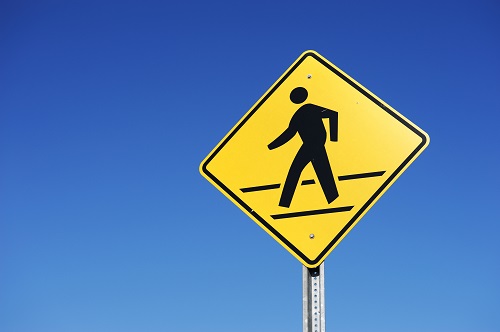Pedestrian Deaths Reach Highest Number in 41 Years
A sobering look at a troubling trend
The U.S. has witnessed an alarming increase in pedestrian fatalities in recent years. And according to a new report by the Governors Highway Safety Association (GHSA), the number of pedestrian deaths has now soared to levels unseen in the past 41 years.
In 2022 alone, at least 7,508 pedestrians died, marking the highest death toll in four decades. And since 2010, pedestrian fatalities have increased by 77%, well ahead of the 25% increase in other traffic-related deaths.
“Every day, 20 people go for a walk and do not return home,” Jonathan Adkins, chief executive officer of the safety group, said in a statement published by Forbes. “These are people living their daily lives – commuting to and from school and work, picking up groceries, walking the dog, getting some exercise – who died suddenly and violently.”
This rise in serious and fatal pedestrian accidents is primarily attributed to dangerous driving habits, insufficient infrastructure, and the popularity of larger, heavier vehicles like SUVs. The report underscores the urgent need to address the ongoing crisis of pedestrian safety on our roads and highlights the need for injured pedestrians to hold negligent drivers accountable.
Pedestrian accident statistics
The GHSA report, titled “Pedestrian Traffic Fatalities by State,” presents preliminary data from 2022 and highlights the ongoing increase in pedestrian deaths over the past decade.
It also emphasizes that dangerous driving behaviors that emerged during the pandemic in 2020 have not subsided.
The report provides several insights into pedestrian safety trends from 2010 to 2021, including:
- Most pedestrian fatalities occur at night, and nighttime deaths have increased in recent years.
- Due to their taller profile and bigger blind spots, SUVs and light trucks pose a greater risk to pedestrians on a per-vehicle basis. While fatal pedestrian crashes involving passenger cars remain the highest in number due to the sheer quantity of cars, deaths involving SUVs have increased at a much faster rate (120% compared to 26% for passenger cars) in the past decade.
- The absence of sidewalks continues to be a significant factor in pedestrian fatalities, with 69% of deaths occurring in areas without sidewalks in 2021, showing a steady increase from 59% in 2017.
- The risk of pedestrian death exponentially increases with higher vehicle speeds, ranging from 10% at 23 mph to 90% at 58 mph. In 2021, 8.1% of pedestrian fatalities involved speeding drivers, slightly lower than the previous year but higher than pre-pandemic levels.
- Drunk driving is the main contributing factor in 19 percent of pedestrian accident deaths.
- Non-freeway arterial roads pose the highest risk to pedestrians, accounting for 60% of all fatalities. These roads typically have high traffic volumes, high speeds, and eventually connect to freeways. About 18% of pedestrian deaths occur on freeways, often involving stranded motorists, first responders, and tow truck drivers. The report recommends strengthening and promoting Move Over laws that require drivers to slow down and change lanes when approaching stopped vehicles.
The GHSA report also listed the number of pedestrian fatalities by state from 2019 to 2022. In 2019, there were 661 pedestrian deaths in Texas, which increased to 714 in 2020. In 2021, the number rose further to 826 fatalities. In the most recent data available, the preliminary figures for 2022 show a slight increase to 834 deaths.
Addressing the problem
The report emphasized the importance of addressing dangerous driving behaviors such as speeding, impaired driving, and distracted driving through targeted traffic enforcement.
It also highlighted the need to educate new drivers about their responsibility to be aware of and yield to pedestrians and other road users.
Additionally, the GHSA advocated for adopting the Safe System approach to road safety, which originated in Sweden in the 1990s. This approach aims to eliminate all road deaths and serious injuries by implementing various layers of protection, including safer road design, safer vehicles, safer speeds, and improved post-crash care.
Claims involving pedestrian accidents can be complicated
Insurance companies often employ various tactics to downplay or deny pedestrian accident claims to minimize their financial liability. Common strategies include:
- Challenging fault: The insurance company for the at-fault driver may try to shift blame onto the pedestrian by arguing that the pedestrian was distracted, jaywalking, or acting negligently at the time of the accident, thereby reducing or eliminating the insurance company’s responsibility to provide compensation for the victim’s losses.
- Disputing injury severity: Insurers may claim that the pedestrian’s injuries are less severe than stated or attribute damages to pre-existing conditions.
- Questioning medical treatment: Insurance companies may raise doubts about the necessity or extent of medical treatments, aiming to reduce the claim amount.
- Delay tactics: Prolonged investigations and excessive documentation requests can be used to frustrate a claimant and discourage them to the point of accepting a lowball settlement offer or giving up on the claim altogether.
To navigate these complexities and ensure their rights are protected, it is crucial for victims to seek the guidance and representation of a lawyer experienced in pedestrian accident claims. An attorney can help gather evidence, negotiate with the insurance company, advocate for the pedestrian’s best interests, and pursue the maximum compensation they are entitled to under the law.
Contact Smith & Hassler for a free case evaluation
Our Houston-based law firm is committed to fighting for the compensation injured pedestrians deserve. With decades of experience, we understand what it takes to get meaningful results for accident victims and their families.
If you were hit by a car or a loved one died in a pedestrian accident, we can guide you through the legal process and help you hold the at-fault driver accountable for your losses.
To learn more about how we can help with your potential legal case, contact us today for a free case evaluation.





